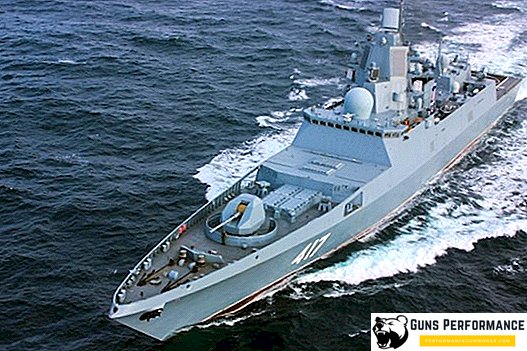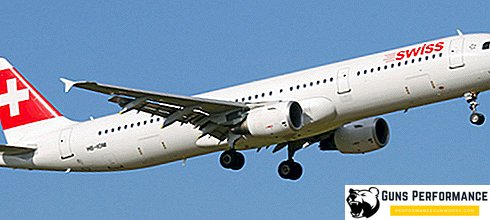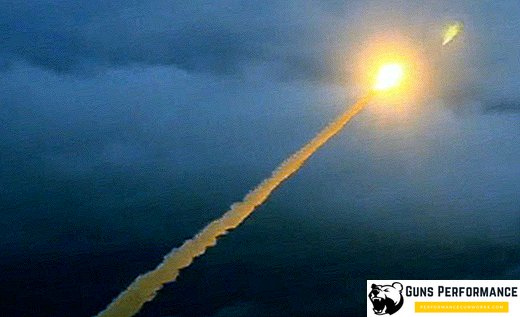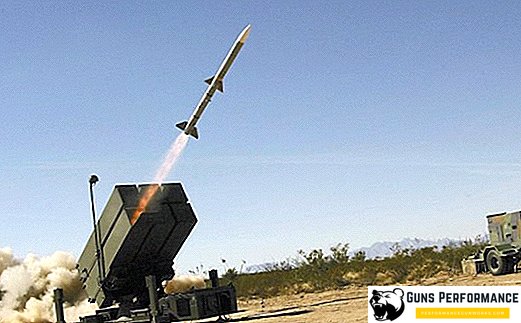The appearance of explosives on the battlefield is due to the natural desire to inflict as much a striking effect on the enemy. Initially, explosives performed work on the destruction of long-term fortifications. Later began to appear various directional ammunition, which were equipped with the first artillery systems. The main damaging factor in such ammunition was the explosive factor, determined by the amount of explosive inherent in the ammunition; however, for combat effectiveness, not always the power of the charge is the key point.
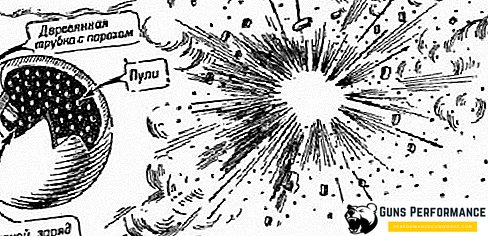
With the increase in the share of active use of firearms, it was necessary to increase the striking factor of ammunition for a successful fight on the battlefield with enemy manpower. The high-explosive ordnance, possessing considerable destructive force, had a limited zone of destruction. Through lengthy trial and error, we managed to find out that the maximum effect when using artillery shells against the enemy manpower is achieved due to the flying parts of the exploding projectile. The next step on the path of increasing the damaging factor of the types of firearms used was fragmentation ammunition. First artillery systems appeared, fired by exploding bombs, and later shrapnel appeared. The effect of the use of fragmentation shells on the battlefield was striking. Fragments of the bomb and shrapnel, scattering after the explosion, caused maximum damage to manpower.
The infantry was forced to seek protection from the action of fragmentation bombs in shelters, and cavalry was used only on limited areas of the front for strikes. A new type of ammunition made significant adjustments to the tactics of combat. Now, not only the artillery could completely decide the outcome of the battle in one direction or another, but the infantry, armed with grenades, had at its disposal effective means of fire fighting.
Fragment ammunition - principle of operation and types
The military, having detected certain factors in the operation of individual ammunition, prompted military engineers to supply ordinary ammunition, an artillery shell or a hand bomb with additional elements. When the projectile was torn, these elements, having received a huge impulse of kinetic energy, flew away from the explosion site at a certain distance. In other words, another hazardous component, a fragmentation factor, was added to the high explosiveness, which is common to any explosive. Accordingly, the affected area of such a warhead has increased. It has already been said above that the first types of fragmentation ammunition were shrapnel, a shell filled with bullets that flew at the time of the explosion.

In the future, fragmentation ammunition (OBP) are becoming more common due to the large variety of designs. This was one of the reasons for the mass transition of almost all types of weapons, where explosives are used for fragmentation and high-explosive fragmentation ammunition. Depending on the principle of operation and the design of fragmentation ammunition, their method of delivery changed, the range of combat missions significantly expanded. Despite the fact that this type of ammunition is not officially classified, they are usually divided according to the following criteria:
- by the method of delivery to the target;
- by the type and size of the target;
- in the form and configuration of the fragmentation field;
- on damaging elements (form and method of formation).
The first criterion - the method of delivering OBP to the target - was developed in the 20th century, when the existing artillery systems improved, new types of weapons appeared. The most massive delivery method is artillery fire and rocket fire. To mechanical methods of delivery is an airstrike. Another important is the manual delivery method, where fragmentation grenades are operated and used directly by humans. This type of ammunition is widespread and remains one of the most important elements of individual equipment today.

This type of ammunition will differ in the type of target being hit. At the moment in combat conditions, the main means of counteraction are multi-purpose ammunition, high-explosive fragmentation action. These are, as a rule, artillery howitzer shells, mortar shells, aerial bombs. Specialized ammunition is used to counter the targets of a specific plan. These munitions include:
- anti-personnel mines;
- anti-vehicle mines;
- cluster bombs;
- hand grenades of various actions.
Howitzer shells, mortar shells and air mines are designed mainly to defeat manpower. During the explosion of such a munition in large quantities fragments, large and small, flying at a considerable distance. With the explosion of a single charge of fragmentation action, the affected area can vary in the range of 150-300 m. The use of ball or cluster shells through the use of multiple charges, the affected area is increased several times, reaching an area of 1-2 ha.

To the note: a cluster bomb bomb contains up to 300 small metal or plastic balls, which, when the main charge is broken, scatter over a large area, in turn, breaking into thousands of tiny fragments. The striking elements in such ammunition are steel needles, balls or arrows.
Key factors for the effectiveness of combat SSBs
The type of ammunition depends on the configuration of fragmentation fields. This factor is decisive for the combat use of shells, mines, bombs and grenades. The effectiveness of the listed ammunition in various situations. The fragmentation field configuration can be of four types:
- circular;
- asymmetrically radially directed;
- axial;
- low speed, flat.
The first type is characteristic of most high-explosive artillery mines and shells, aerial bombs, missiles and missiles. The second type includes warheads of shells, missiles and other fire weapons with multipoint initiation. Engineering ammunition, anti-personnel mines and shrapnel, shells with axial warheads have an axial configuration of fragmentation fields.
The latest fourth type is characteristic of combat units of missiles and air defense shells. Such munitions are designed to hit air targets on all flight horizons. The most common circular configuration fragmentation ammunition is mortar bombs, aerial bombs, and fragmentation grenades. It is their use that is designed mainly for a circular, massive defeat of enemy personnel over large areas.

High-explosive fragmentation shells of artillery systems and tank guns have an asymmetrically radially directed configuration. This contributes to the gentle trajectory of the projectile. When it hits the target, the projectile explodes, discarding most of the fragments in the direction of the projectile’s flight. These munitions have a significant damage area, but there are dead spaces in it.
The effectiveness of OBP is influenced by the method of formation of damaging elements. In modern ammunition, there are three ways of forming fragments:
- with natural crushing shell shell;
- for a given crushing shell shell;
- shells equipped with ready-made striking elements.
The first method is the most common. Virtually all fragmentation mines, aerial bombs and artillery shells have striking elements arising in a natural, uncontrolled way by crushing into small and large particles of the shell of an ammunition. As a rule, the ammunition shell has an asymmetric body made of carbon steel. The steel casing of a bomb, mine or projectile is easily subject to dynamic destruction as a result of an explosive blast. The effectiveness of the use of ammunition with striking elements of natural crushing is influenced by the method of explosion, the quality of the steel from which the warhead is made. As a rule, such munitions have large (75-90 °) angles of incidence, as a result of which a large area of shrapnel damage is achieved.

The second type includes fragmentation grenades and mortar mines, the hull of which has special notches that contribute to the formation of fragments of a certain shape and size when explosive explodes. A vivid example of such an ammunition is the F-1 hand grenade, the body of which is divided into fragments of a certain size and shape. The device for manual fragmentation grenades is arranged in such a way that when an explosive is blown up, the body of the grenade is destroyed into small particles. Scattering around at high speed, the fragments cause deep wounds to manpower. The use of manual fragmentation grenades requires compliance with certain rules and safety requirements, the violation and non-observance of which can lead to the opposite effect. Failure to comply with the distance in the combat use of manual grants can result in a serious injury to the applicants.
The third method of forming attack elements is characteristic of special ammunition, the task of which is to inflict as much traumatic damage to manpower as possible over a wide area. Of this type, shrapnel ammunition and cluster bombs are best known. Their main filling is a large number of artificial attack elements (needles, arrows, balls). When an air bomb blast of this type of ammunition is achieved the largest possible area of destruction.
Fragment ammunition, as a means of enhancing the fire capabilities of small arms
In modern small arms today, a number of functions have been added that increase the shooter’s firepower by an order of magnitude. Having received automatic rifles and machine guns with grenade launchers, the shooter had the opportunity to hit the enemy at a greater distance using fragmentation cartridges. At the same time, the safe distance of the fire contact was maintained.
This type of ammunition is very convenient and effective in close combat, where the distance to the target does not exceed 50-100 meters. In comparison with manual fragmentation grenades, the use of which in a limited space did not give the desired effect, this type of ammunition has several advantages. Under the action of a manual fragmentation grenade, it is rare that the direction of the fragmentation field coincides with the direction of firing. The front hemisphere often becomes a dead space, while most of the fragments fly in the direction of the person who threw the grenade. This type of ammunition has radially directed fragmentation fields and is equipped with artificial attack elements.
Modern grenade launchers are equipped with fragmentation cartridges that have a completely different principle of operation. When hitting the target, the explosive charge undermines, which spreads artificial attack elements at a small angle to the point of impact of the projectile. Fragment cartridges become ammunition for carrying out attacking actions.
The main advantages and disadvantages of fragmentation ammunition
Each type of fragmentation ammunition has its pros and cons. The main advantages include a large striking effect, achieved as a result of fragmentation shells, mines, aerial bombs and hand grenades. At high angles of incidence of shells in the target, the maximum striking effect of a circular fragmentation field is achieved. Accordingly, the use of aerial bombs, mortar shells and howitzers of a type for other purposes will not have the desired effect.

Combat use of specialized fragmentation ammunition increases the affected area in a certain direction, acting directly on the target. High-explosive shells belong to the combined type of ammunition. They are equipped with all cannon and rocket artillery leading the shooting of a ballistic trajectory, aerial bombs. For artillery tank guns, barrels, firing on a flat trajectory, the use of fragmentation ammunition is not advisable.
To date, fragmentation ammunition with fragmentation fields of circular action, retain their position among the ground ammunition. The main field of application is the suppression of enemy manpower over vast areas, causing damage to the social infrastructure of the enemy.
When using anti-aircraft ammunition, the maximum effect is achieved through the creation of an axial or low-speed flat fragmentation field. A similar principle of action has new hand fragmentation grenades, where the fragments scatter in a certain plane, creating a zone of destruction in the right place and for specific purposes. Anti-personnel, anti-vehicle and mortar mines have an axial fragmentation field, where the direction of fragmentation of fragments is a strictly chosen direction.



